GPTZero AI Detector Review: How Accurate Is It? Real Tests

These days, it’s getting harder to tell human writing from AI-generated text.
Tools like GPTZero claim near-perfect accuracy, but it’s natural to wonder—how reliable are they really? Can they actually spot AI from human writing?
In this article, we’ll break down how GPTZero works, how accurate it is, its key features, pricing, and even ways people try to get around it. Whether you’re curious, cautious, or just skeptical, this guide will help you get a clear picture of what to expect.
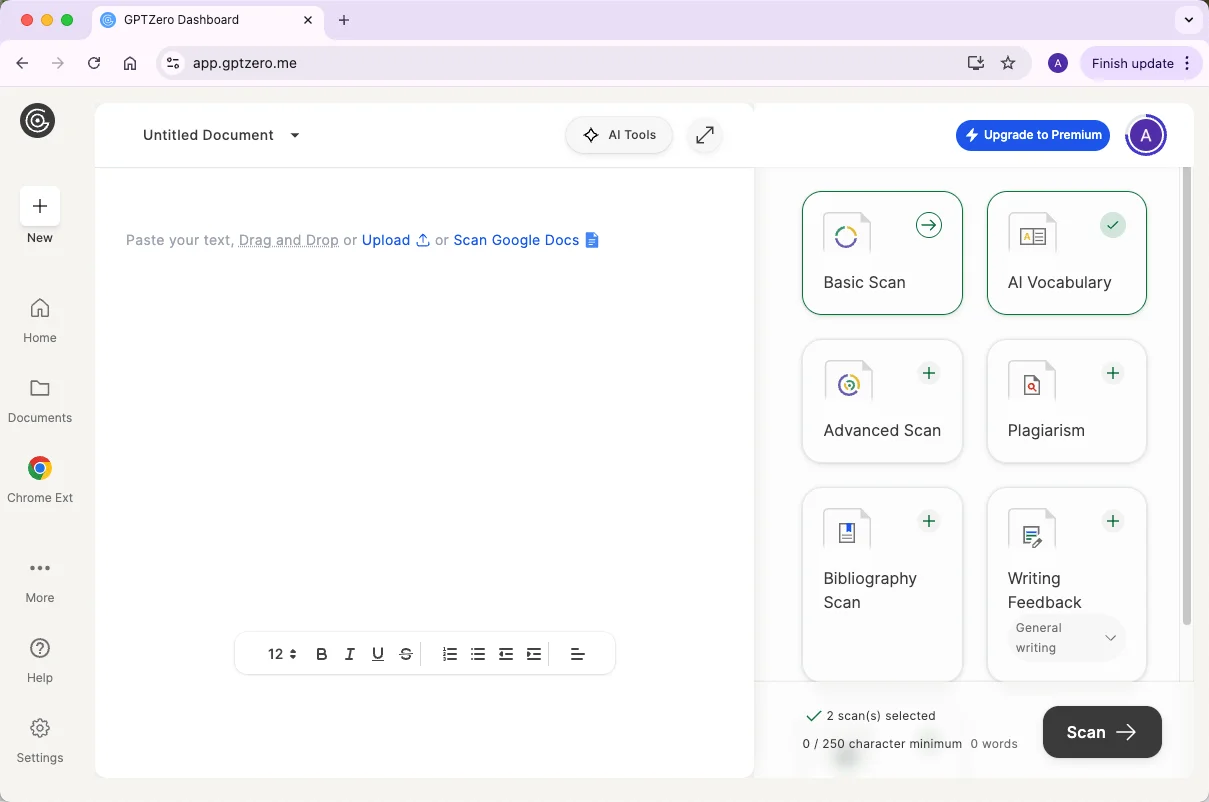
What is GPTZero and How Does Its AI Detector Work?
GPTZero is an AI detection tool designed to help students, writers, and educators identify whether a piece of text was written by a human or generated by AI. It uses advanced algorithms to provide more than a simple “AI or Human” verdict, giving users a detailed look at text authenticity.
How GPTZero AI Detector Works
GPTZero analyzes text using three main methods:
Perplexity Analysis – Measures how “surprised” a language model is when predicting the next word. Human writing tends to be less predictable, showing higher perplexity, while AI-generated text is more uniform.
Burstiness Analysis – Look at sentence patterns. Human writers naturally vary sentence length and complexity, whereas AI often produces consistent, evenly structured sentences.
Highlighted AI Phrases – Identifies phrases or sentences most likely written by AI, making it easy to see what triggered the detection.
Supported Formats
GPTZero is flexible and works with a variety of input types:
Text Input – Paste text directly into the platform.
Document Uploads – Supports files like Word or PDF.
API Integration – Developers can integrate GPTZero into their systems for automated detection.
Learning Platforms & Tools – Compatible with Google Docs, Chrome, Canvas, Moodle, Google Classroom, and Zapier.
Other Key Features of GPTZero
Mixed-Content Detection – Can identify text that blends human and AI writing.
Plagiarism Check – Scans for copied content from external sources.
Advanced Scan Options – Includes AI model classification, human writing verification, and detailed reports.
Writing Feedback & AI Tutor – Provides guidance for improving writing while fostering responsible AI usage.
Multi-Model Detection – Detects text generated by various AI models, including ChatGPT, Claude, Gemini, and LLaMA.
How Accurate is GPTZero? Testing Process & Results
Detecting AI-generated content is one thing—proving it in practice is another. GPTZero claims up to 99% accuracy, but we wanted to test this ourselves. To provide a realistic evaluation, we ran three types of tests: pure AI text, mixed AI + human writing, and humanized AI text. Our goal was to see how reliably GPTZero could classify content and highlight AI-influenced passages.
Test 1: Pure AI Text
Setup:
We generated a short essay using ChatGPT on a typical college topic and submitted it to GPTZero. The text was entirely AI-written with no human edits.
Results: 100% AI-generated
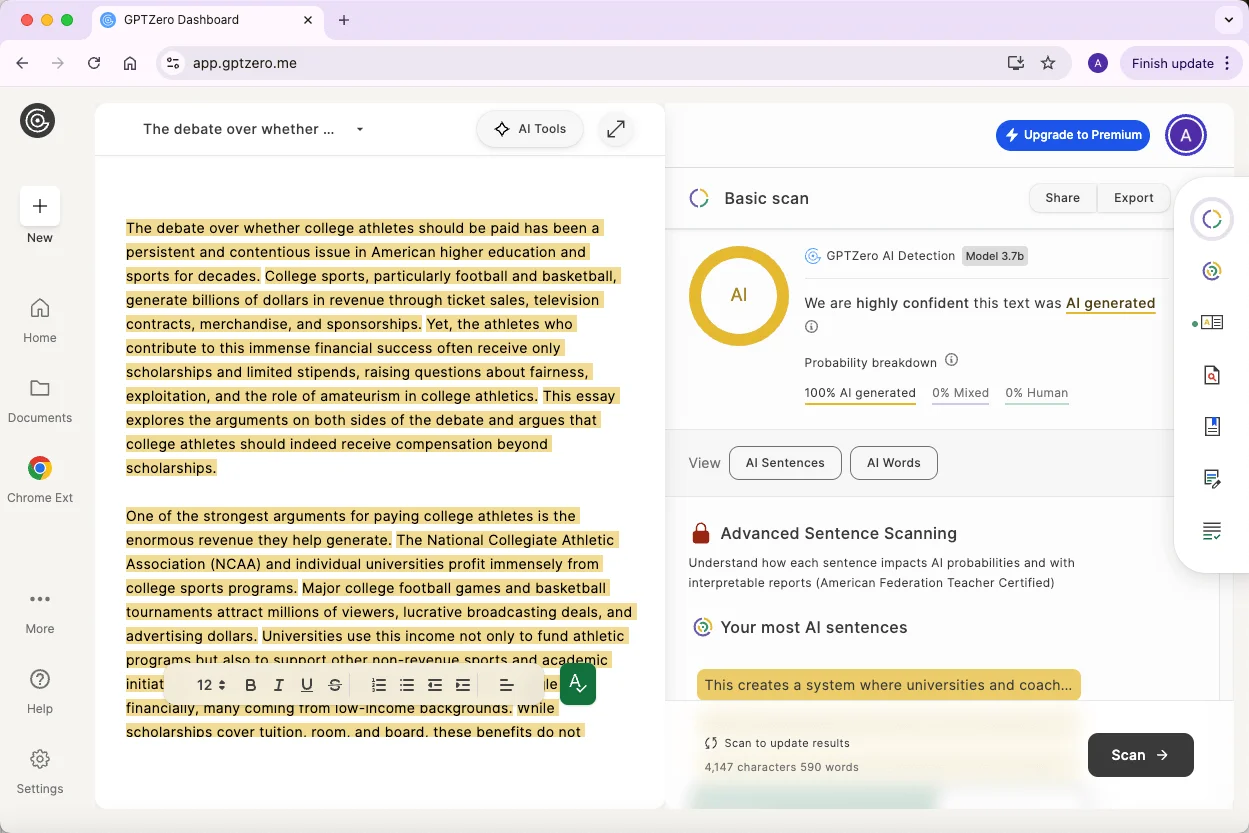
Observations:
GPTZero accurately flagged all AI-generated sentences. Statistically, the detector achieved a 100% detection rate for pure AI text in this sample. This confirms GPTZero performs exceptionally well when dealing with unmodified AI content.
Test 2: Mixed AI + Human Writing (Before the ChatGPT Era)
Setting:
We selected a portion of a paper written before the AI boom and continued it using ChatGPT. The total word count was 454 words, with 187 words originally human-generated (about 41%).
Results:
AI-generated: 21%
Hybrid: 45%
Human: 34%
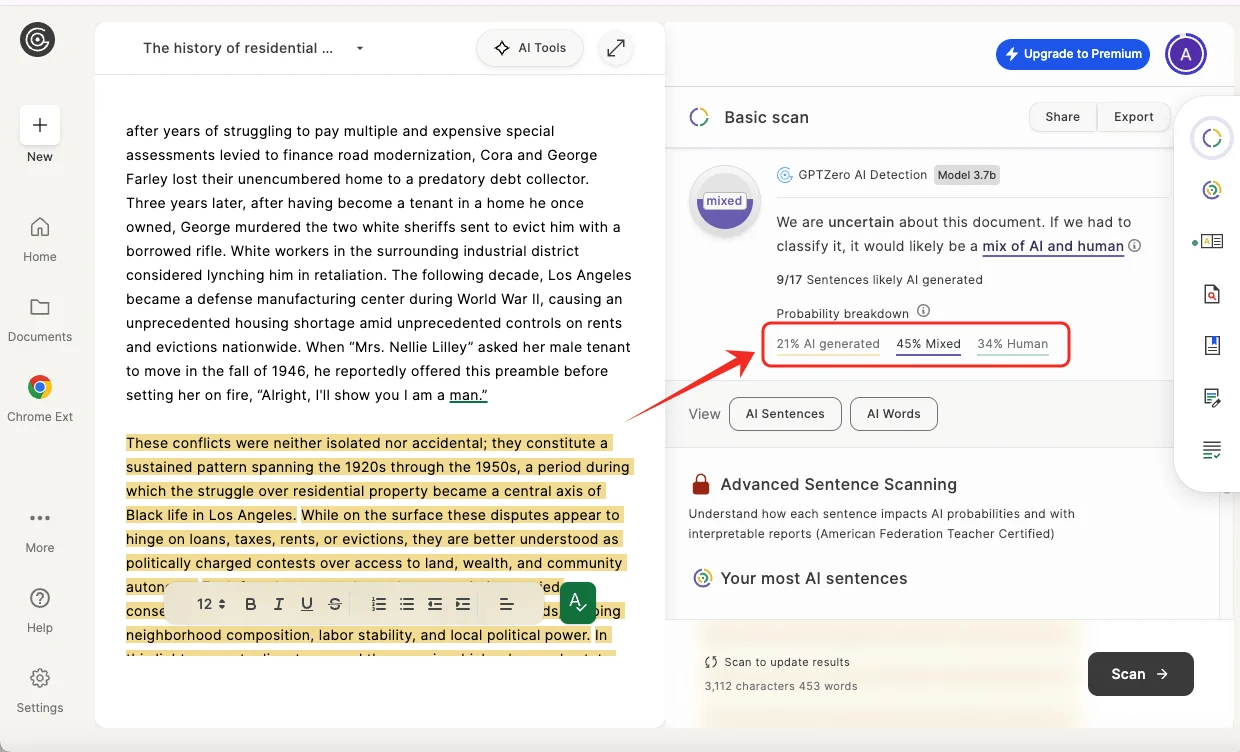
Observations:
GPTZero captured the AI portions reasonably well but showed overlap in the hybrid section, reflecting the challenge of detecting blended content. While it didn’t mislabel human sentences as fully AI-generated, the mixed nature caused some misclassification. This highlights that hybrid texts can reduce detection accuracy, yet GPTZero still provides a useful estimate of AI involvement.
Test 3: Humanized AI Text (QuillBot AI Humanizer)
Setup:
We lightly humanized an AI-generated essay using QuillBot, making minor edits to phrasing and sentence flow without changing the overall structure.
Results:
AI-generated: 29%
Mixed: 0%
Human: 71%
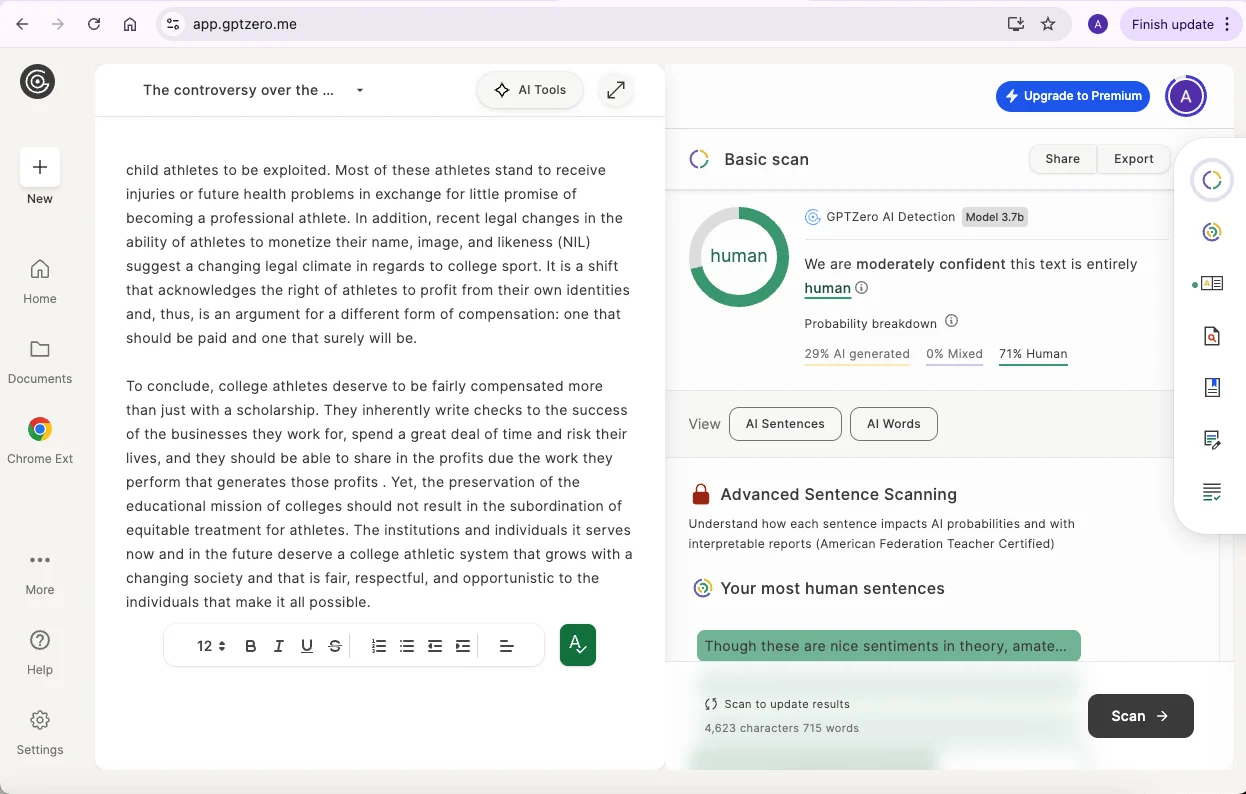
Observations:
Even with light humanization, GPTZero still detected some AI traces, but most of the text was classified as human. This indicates that minor paraphrasing can significantly reduce AI detection, although full obfuscation would require deeper structural or linguistic changes. In statistical terms, GPTZero’s sensitivity dropped by approximately 70% when minor humanization was applied, reflecting its partial reliance on detectable AI sentence patterns.
Pros and Cons of GPTZero
Like any AI detector, GPTZero shines in some areas but has room for improvement in others. Based on our testing and user feedback from forums, here’s a breakdown of what it does well—and where it might fall short.
Pros
High accuracy for pure AI content – In our tests, GPTZero consistently achieved 98%+ accuracy when detecting unedited AI writing from models like ChatGPT, Claude, and Gemini.
Lower cost per word – For large-scale scanning, GPTZero’s pricing is competitive compared to premium detectors.
Free version available – Ideal for quick, occasional checks without a subscription.
Additional features beyond detection – Tools like Human-Written Reports, Reference Scanning, and AI Tutors add real educational value.
Model diversity – Supports detection across multiple AI systems, including GPT-2, GPT-4, Claude, Gemini, and LLaMA.
Easy integration – Works with Chrome, Canvas, Moodle, Google Docs, and Google Classroom, fitting seamlessly into academic workflows.
Sentence-level analysis – Highlights suspicious sentences for targeted editing, along with basic formatting and quick modifications to flagged text.
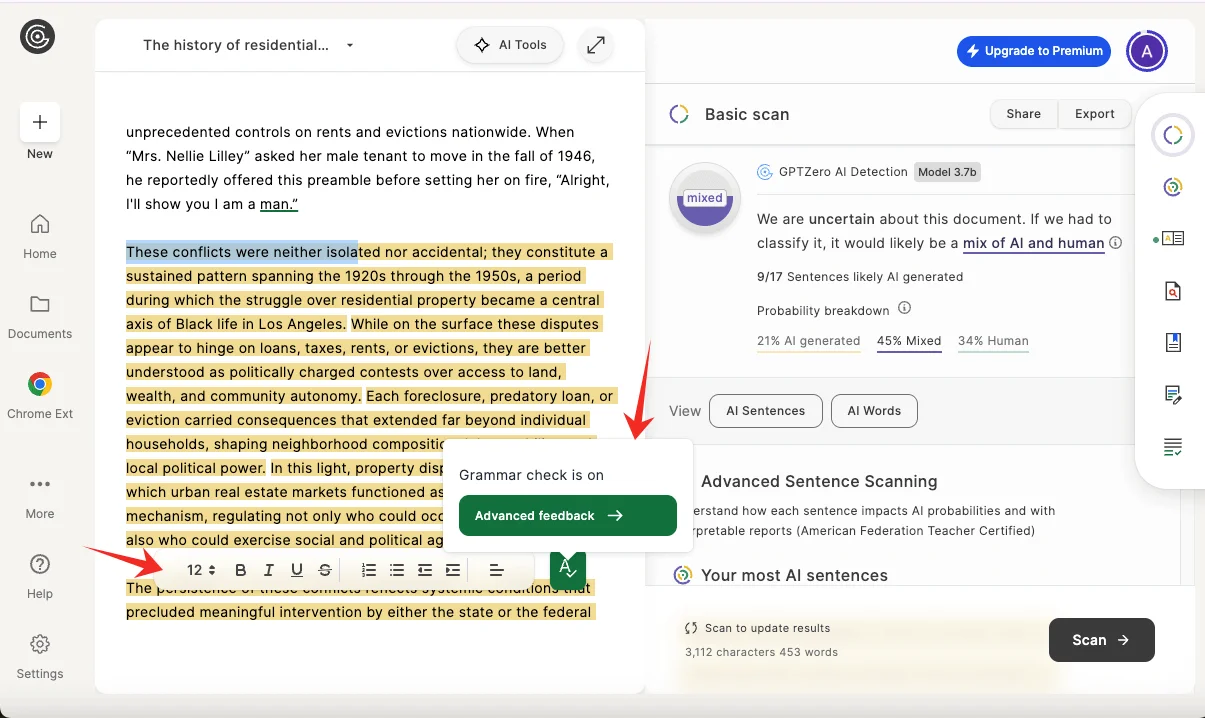
Cons
Potential for false positives – Some human-written sentences—especially those with formal or repetitive phrasing—may be flagged as AI-generated.
Lower accuracy for humanized AI – Lightly rewritten AI content can significantly reduce detection rates, allowing partially hidden AI influence.
No scan history – Results are not stored, making them hard to download or share later.
Limited language support – Best performance is in English; accuracy in other languages is unclear.
Not a top performer in all benchmarks – Some independent studies suggest tools like Turnitin or Originality.AI may outperform GPTZero in certain challenging cases.
GPTZero Pricing – Free vs. Paid
Speaking of pricing, GPTZero is designed to fit a range of needs—from students who just need occasional checks to professional teams scanning hundreds of pages daily.
Free Version
If you’re just testing the tool, GPTZero offers a free plan with a limited word quota. It’s perfect for quick one-off checks, but you won’t get premium perks like plagiarism detection, advanced scanning, or bulk uploads.
Paid Plans
GPTZero’s paid subscriptions start at $14.99/month, with discounts for annual billing. There are three main tiers, each offering different word limits and feature sets:
Plan | Word Limit | Features | Ideal For |
Basic | 150,000 words/month | AI scanning, grammar checker, AI vocabulary checker, Chrome extension | Amateur writers and light users |
Premium | 300,000 words/month | Everything in Basic, plus advanced scanning, writing feedback, plagiarism checker, and citation tools | Students and professionals needing in-depth text analysis |
Professional | 500,000 words/month (+ up to 10M overage) | Everything in Premium, plus batch scanning (up to 250 files), page-by-page review, team collaboration, LMS integration | Schools, publishers, and enterprise teams handling high-volume scanning |
Can You Bypass GPTZero’s AI Detectors?
GPTZero’s detection system is highly sensitive to AI-generated content, which means that even lightly AI-assisted text can trigger flags. While bypassing detection is possible, it’s not as simple as swapping out a few words. Basic paraphrasing or synonym replacement often fails because GPTZero doesn’t just check vocabulary—it analyzes sentence structure, rhythm, and statistical patterns. In our earlier tests, using Quillbot for light edits improved scores by around 30%, but detection still remained significant.
This is where professional tools like EssayDone Humanizer make a real difference. EssayDone’s humanization technology goes beyond surface-level rewriting, restructuring text at both the sentence and paragraph level. It skillfully introduces linguistic variety and stylistic traits common in human writing, breaking the uniformity and predictability that GPTZero often relies on to flag AI text.
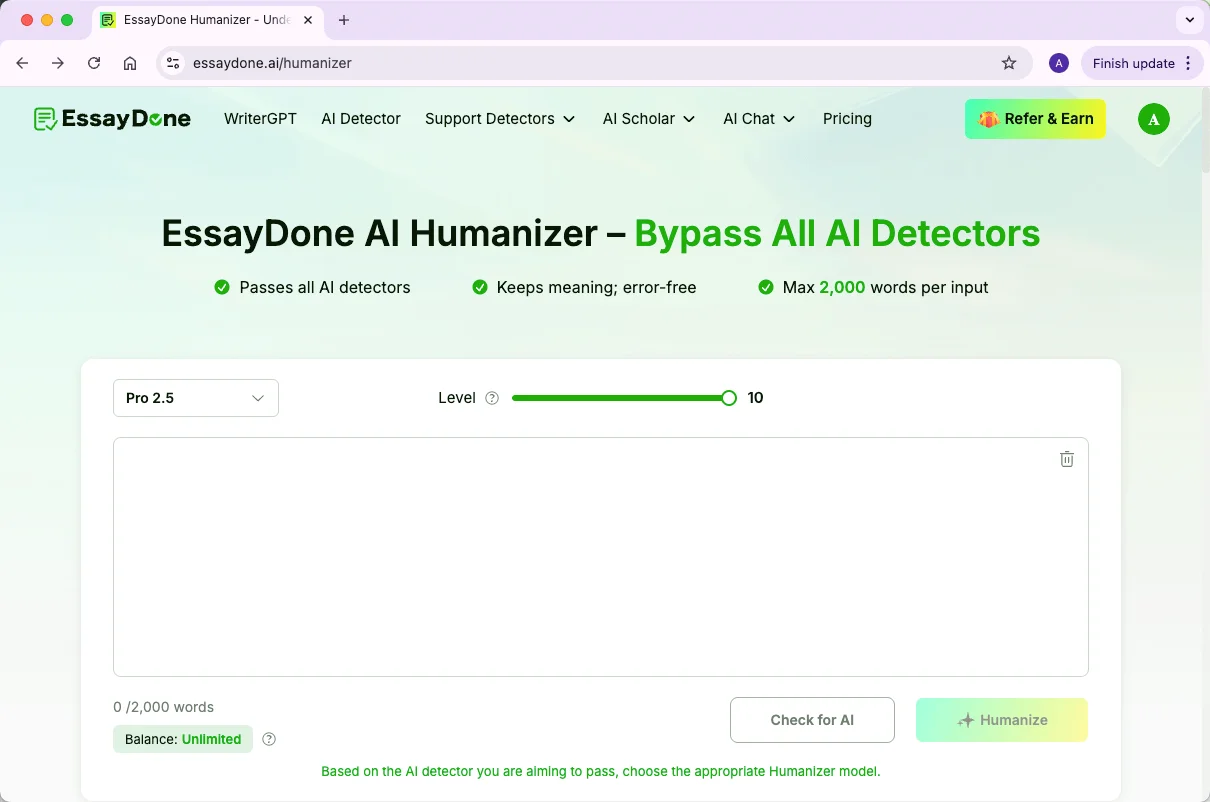
GPTZero’s detection hinges on perplexity (how unpredictable the next word is) and burstiness (variation in sentence length and complexity). AI typically produces evenly paced, predictable text, while humans naturally mix short and long sentences, use idioms, and add subtle irregularities. By making deep structural and stylistic changes—rather than simply swapping words—EssayDone strengthens these “human-like” signals, significantly lowering detection rates.
In our tests, we took 100% AI-generated text from Test 1, processed it through EssayDone’s advanced humanizer, and re-scanned it with GPTZero.
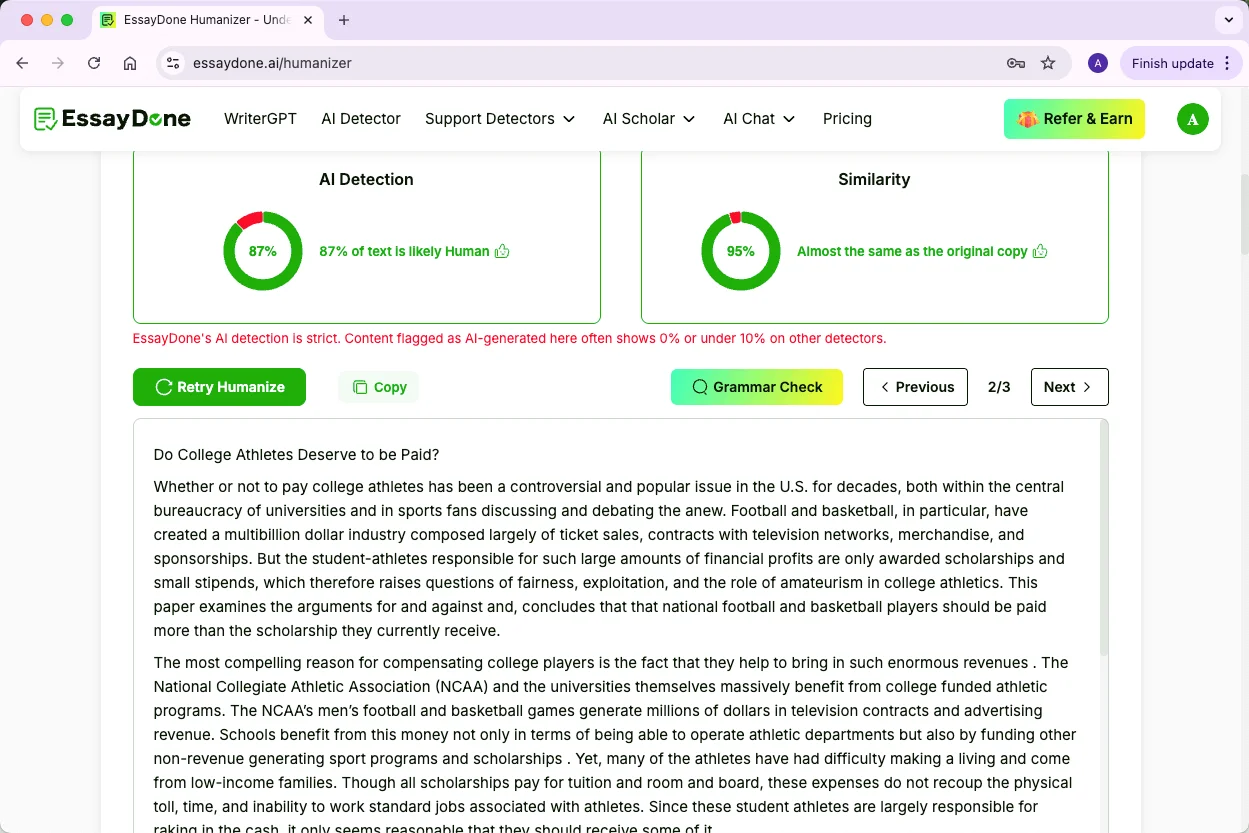
The result? 0% flagged as AI-generated—without altering the original meaning or compromising grammar quality.
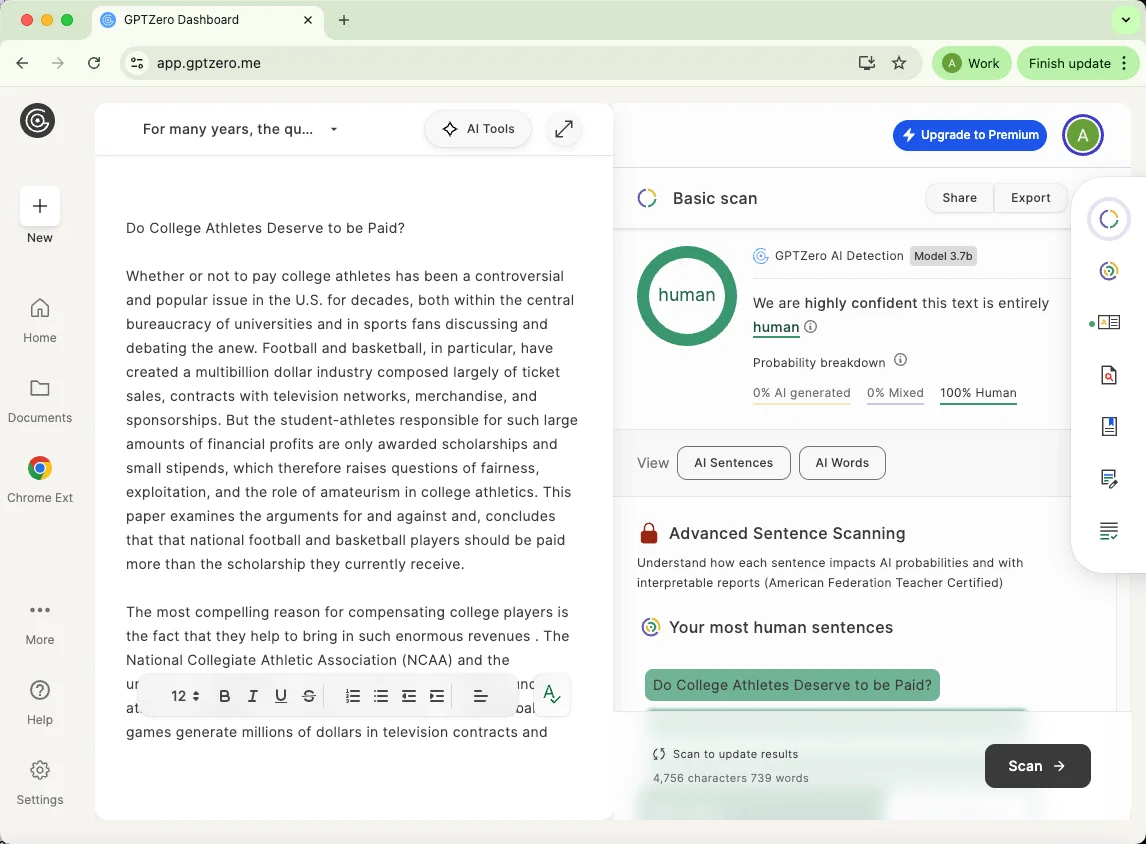
Alternatives to GPTZero
While GPTZero is one of the most well-known AI detectors, it’s not the only option. Depending on your budget, accuracy needs, and workflow, you might find other tools better suited for your use case. Here are some top contenders:
ZeroGPT
A free and widely accessible AI detector that’s popular with casual users. It offers quick checks without requiring an account, but its accuracy can vary, especially on heavily edited AI text.
Grammarly
Primarily known as a grammar and style checker, Grammarly has started integrating AI content detection. It’s a great option for writers who want a single tool for both quality improvement and AI detection, though its AI scanning is still in early stages compared to dedicated detectors.
Originality.AI
Built for professional content publishers, Originality.AI offers high detection accuracy, even for mixed AI-human text. It also includes team management features and a pay-as-you-go pricing model, making it scalable for agencies.
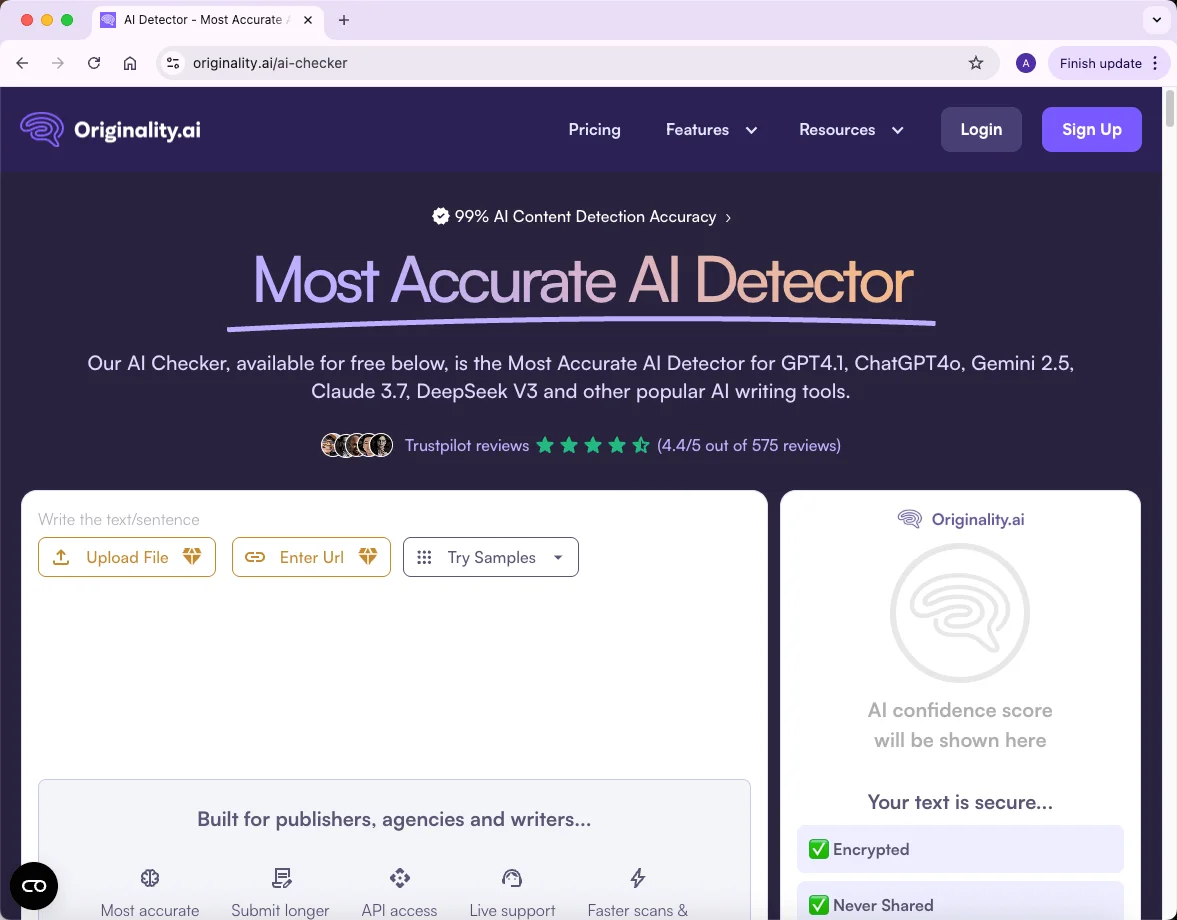
Copyleaks
A robust plagiarism and AI detection platform trusted by educators and businesses. It supports multiple languages and can scan for both AI-generated and paraphrased plagiarism, making it strong for academic and publishing use.
Scribbr
Best known for plagiarism checks, Scribbr now offers AI content detection aimed at students and academic writers. It integrates with its citation and proofreading tools, making it a one-stop shop for academic compliance.
Winston AI
Favored by educators for its high accuracy with ChatGPT content, Winston AI also provides a readability score and document management features. It’s optimized for classroom use and LMS integration.

FAQ
Is GPTZero 100% accurate?
No AI detector is perfect. GPTZero performs well on unedited AI text but can misclassify lightly humanized or mixed writing. Small paraphrasing or stylistic changes may lower detection accuracy, so some AI-assisted content might appear human-generated.
How can I bypass GPTZero?
Simple word changes often fail. Tools like EssayDone restructure sentences, vary phrasing, and add natural human-like patterns. This reduces the detectability of AI-generated text by addressing linguistic and structural cues, while preserving the original meaning and readability.
Will my professor use an AI detector?
Some professors do use AI detectors, but it varies by school and instructor. Many schools rely on tools like Turnitin, which has started integrating AI detection, while others may use GPTZero or alternative software. Ultimately, it depends on your institution’s policies and the professor’s preferences.
Can I check my own work?
Yes, it helps ensure AI-assisted text won’t be flagged before submission.
Are AI detectors legal?
Yes. They’re similar to plagiarism checkers and are intended to verify originality.
Conclusion
We’ve covered everything about the GPTZero AI detector in detail—from how it works and accuracy testing to pros and cons, pricing, and alternatives. With all this info, you can clearly see its strengths and limitations.
We also touched on bypassing detection: gently humanizing text may help, but using a professional humanizer is more reliable. Hopefully, this guide helps you write smarter, more confidently, and make the most of the tools available.
